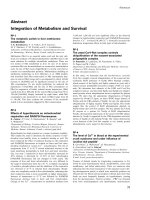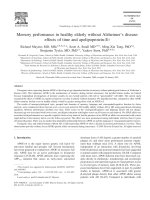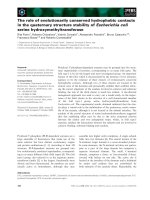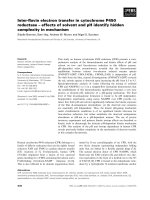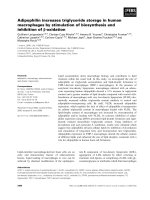Plants in Alpine Regions Cell Physiology of Adaption and Survival Strategies pptx
Bạn đang xem bản rút gọn của tài liệu. Xem và tải ngay bản đầy đủ của tài liệu tại đây (8.88 MB, 215 trang )
.
Cornelius L
€
utz
Editor
Plants in Alpine Regions
Cell Physiology of Adaption
and Survival Strategies
SpringerWienNewYork
Editor
Prof. Dr. Cornelius L
€
utz
University of Innsbruck
Faculty of Life Sciences
Institute of Botany
Sternwartestr. 15
6020 Innsbruck
Austria
This work is subject to copyright.
All rights are reserved, whether the whole or part of the material is concerned, specifically those of
translation, reprinting, re-use of illustrations, broadcasting, reproduction by photocopying
machines or similar means, and storage in data banks.
The use of registered names, trademarks, etc. in this publication does not imply, even in the
absence of a specific statement, that such names are exempt from the relevant protective laws
and regulations and therefore free for general use.
# 2012 Springer-Verlag/Wien
SpringerWienNewYork is a part of Springer Science+Business Media
springer.at/
Cover illustrations: upper left: alpine Oxyria digyna; lower left: antarctic Deschampsia
antarctica prepared for measurements; right: Central Alps, Tyrol.
Typesetting: SPi Publisher Services, Pondicherry, India
Printed on acid-free and chlorine-free bleached paper
SPIN: 12767885
With 112 Figures
Library of Congress Control Number: 2011938122
ISBN 978-3-7091-0135-3 e-ISBN 978-3-7091-0136-0
DOI 10.1007/978-3-7091-0136-0
SpringerWienNewYork
Preface
Plants inhabiting high alpine and nival zones are considered as living in an extreme
environment.
Extreme environments have been attractive for explorers for centuries, and now-
adays they also attract tourists. Fortunately biological science is becoming increas-
ingly aware that these remote habitats provide challenging questions that will help to
understand the limits of life functions. Biota of cold, extreme environments have
been brought closer to the scientific community and to the public by international
activities such as the International Year of the Mountains (2002) or the International
Polar Year (2007–2009).
While it is indispensable to use model plants such as Chlorella, Physicomitrella,
Hordeum or Arabidopsis to follow single metabolic processes and pathways or
fluxes, species from remote locations are difficult to use as model organisms: often
they do not grow in culture or they change their metabolism completely under
artificial growth.
Plants at the margins of life developed a broad range of adaptation and survival
strategies during evolution. These are best studied with species growing in extreme
environments – extreme firstly for the researcher, who tries to measure life functions
in the field and to harvest samples for later studies in the home laboratory. This has
been experienced by an increasing number of scientists working in the fields of
geobotany, plant ecophysiology and ecology. Their work has prepared the conditions
that allow different aspects in cell physiology of plants from cold environments (the
same holds for high temperature biota e.g. of deserts, volcanoes) to be studied by
state-of-the-art methods and the results to be interpreted in order to understand the
entire organism, and not merely an isolated function.
This book is devoted to the presentation of a collection of articles on adaptation
and survival strategies at the level of cell physiology. The plants have partially been
investigated in the field and were partially taken directly from alpine or polar habitats
for experiments under lab conditions.
The book contains 14 chapters, written by experts from different research areas.
Most of the contributions are from scientists from the University of Innsbruck. This is
not surprising since the “Alpenuniversit
€
at” looks back on more than 150 years of
research in alpine regions in many fields, including biology, medicine, weather and
climate, geology, geography and others. Surrounded by high mountains, the univer-
sity still is a center of alpine research today. Several topics have been taken up by
colleagues from other universities to integrate their challenging work for a better
description of alpine plant cell physiology.
v
If physiology and cell structural research are not to lose the connection to the
organism, at least partial know ledge of the environmental conditions as determinants
of most life functions should be considered. Therefore, the first three chapters deal
with aspects of the physical environment of alpine plants.
In Chap. 1, M. Kuhn explains the conditions of water input in the form of snow or
rain in the High Alps. Seasonal variations, regional differences and altitudinal effects
or wind exposure strongly determine water and snow situations for the plant com-
munities. The physical characterization of snow cover will help to understand plant
survival in winter. Equally important for plant life and development is solar radia-
tion, characterized by M. Blumthaler in Chap. 2 for the European Alps. Radiation
physics is not an easy issue for plant scientists, but it is well explained in this context.
The variation in solar radiation input in the Alps comes from atmospheric factors
such as aerosols, dust, clouds, ozone, and further depends on altitude, solar angle and
exposure angle of a plant surface to the sun. The biologically effective UV radiation
is at the center of this contribution. Chapter 3 by W. Larcher deals with the biocli-
matic temperatures of mountain plants and connects the first two chapters with the
microclimate which is closer to the plants than general weather descriptions allow.
Macro- and microclimate temperatures show large differences. Less often taken into
account, but of enormous influence are soil temperatures in mountain regions. Soils
buffer the large diurnal temperature changes in high altitudes, thus influencing root
growth. Recording actual temperatures at the plant body or in the canopy provides
important data for understanding plant growth forms and the physiology of tempera-
ture adaptation.
The following Chap. 4 by C. L
€
utz and H.K. Seidlitz describes effects of anthropo-
genic increases in UV radiation and tropospheric ozone. Sophisticated climate
simulations demonstrate that alpine veget ation as well as one of the two Antarctic
higher plants will probably not suffer as a result of the expected increases in UV. In
contrast, ozone, which accumulates at higher levels in European mountains than in
urban environments, may threaten alpine vegetation by inducing earlier senescence.
In a combination of physiological and ultrastructural studies, L
€
utz et al. (Chap. 5)
describe cellular adaptations in alpine and polar plants. Chloroplasts show structural
adaptations, only rarely found in plants from temperat e regions that allow them to use
the short vegetation period in a better way. Possible control by the cytoskeleton is
discussed. These observations reflect high photosynthetic activities; and develop-
ment of membranes under snow in some species is documented. By contrast, the
dynamic of high temperature resistance in alpine plant species is presented by
G. Neuner and O. Buchner (Chap. 6). Tissue heat tolerance of a large number of
alpine species is reported. Heat hardening and developm ental aspects are compared.
As high temperatures in the Alps normally occur under high irradiation, the authors
look more closely at the thermotolerance of photosystem II. Acclimation of photosyn-
thesis and related physiological processes in a broader view are discussed by P. Streb
and G. Cornic in Chap. 7. Aspects of acclimation in alpine plant photosynthesis
include C4 and CAM mechanisms and the PTOX electron shuttle. The protection of
photosynthesis by energy dissipation and antioxidants is also considered.
R. Bligny and S. Aubert (Chap. 8) investigate metabolites and describe high
amounts of ascorbic acid in some Primulaceae. By using sophisticated NMR meth-
ods they also identify methylglucopyranoside in Geum montanum leaves, which may
play a part in methanol detoxification, and finally study metabolites in Xanthoria
lichens during desiccation and hydration. In Chap. 9 F. Baptist and I. Aranjuelo
vi Preface
describe metabolisms of N and C in alpine plants – often overlooked by physiolo-
gists. Plant development depends greatly on carb on fixation and a balanced N uptake
by the roots. Snow cover and time of snow melt determine N uptake for the meta-
bolism. Storage of C and N in alpine plants under the expected climate changes is
described and discussed.
The high mountain flora shows that flowering and seed formation function despite
the often harsh environmental conditions. In Chap. 10 J. Wagner et al. explain how
flower formation and anthesis are regulated by species-specific timing based on the
plant organ temperatures. Snow melt – again – and day length control reproductive
development and seed maturity.
The next two chapters report on recent findings describing adaptation to subzero
temperatures. As S. Mayr et al. show (Chap. 11), alpine conifers are endangered in
winter by limited access to soil water, ice blockages of stored water in several organs,
and frost drought in the needles. Embolism and refilling of xylem vessels are studied
by biophysical methods and microscopy, resulting in a better understanding of the
complex hydraulics in wooden alpine plants. Thematically related, G. Neuner and
J. Hacker discuss freezing stress and mechanisms of ice propagation in plant tissues
(Chap. 12), using alpine dwarf shrubs and herbs. Resistance to freezing stress
depends greatly on plant life forms and developmental stages. The capacity of
supercooling is studied in some species. By means of digital imaging they describe
ice propagation in leaves and discuss the structural and thermal barriers in tissues that
are developed to avoid ice propagation.
D. Remias continues with snow and ice (Chap. 13), now as a habitat, and reports
on recent findings in the cell physiology of snow and ice algae from the Alps and
polar regions. The extreme growth conditions require special metabolic and cell
structural adaptations, such as accumulation of secondary carotenoids (“red snow”)
in the cytoplasm, or vacuolar polyphenols as a protection against high PAR and UV
radiation (glacier ice algae). Photosynthesis is not inhibited by zero temperatures and
not photoinhibited under high irradiation – comparable to many high alpine species.
Even smaller in size, but best acclimated to cold temperatures are microorganisms in
alpine soils, presented by R. Margesin in Chap. 14. These organisms serve as ideal
study objects to characterize cold active enzymes, cold shock proteins and cryopro-
tectans. Microbial activity in alpine soils at low temperatures has an important
influence on litter decomposition and nutrition availability, which connects to higher
plant root activities.
After many years of studying alpine and polar plants under different aspects, it
was a pleasure for me to edit this collection of research contributions; I thank all
colleagues for their participation and effort in presenting their data.
I hope that this book expands the information on cell physiology of alpine/polar
plants including the connection to the physical environment they are exposed to. The
different contributions should encourage more scientists to incorporate plants from
extreme environments in their studies in order to understand the limits of cellular
adaptation and survival strategies.
Finally I would like to thank the Springer team for their support and valuable
suggestions on editing this book, especially Dr. A.D. Strehl and Mag. E.M. Oberhauser.
Innsbruck, spring 2011 Cornelius L
€
utz
Preface vii
.
Contents
1 Rain and Snow at High Elevation 1
Michael Kuhn
2 Solar Radiation of the High Alps 11
Mario Blumthaler
3 Bioclimatic Temperatures in the High Alps 21
Walter Larcher
4 Physiological and Ultrastructural Changes in Alpine Plants
Exposed to High Levels of UV and Ozone 29
Cornelius L
€
utz and Harald K. Seidlitz
5 Cell Organelle Structure and Function in Alpine and Polar
Plants are Influenced by Growt h Conditions and Climate 43
Cornelius L
€
utz, Paul Bergweiler, Lavin ia Di Piazza,
and
Andreas Holzinger
6 Dynamics of Tissue Heat Tolerance and Thermotolerance
of PS II in Alpine Plants 61
Gilbert Neuner and Othmar Buchner
7 Photosynthesis and Antioxidative Protection in Alpine Herbs 75
Peter Streb and Gabriel Cornic
8 Specificities of Metabolite Profiles in Alpine Plants 99
Richard Bligny and Serge Aubert
9 Interaction of Carbon and Nitrogen Metabolisms
in Alpine Plants 121
F. Baptist and I. Aranjuelo
10 From the Flower Bud to the Mature Seed: Timing and Dynamics
of Flower and Seed Development in High-Mountain Plants 135
Johanna Wagner, Ursula Ladinig, Gerlinde Steinacher, and Ilse Larl
11 Plant Water Relations in Alpine Winter 153
Stefan Mayr, Peter Schmid, and Barbara Beikircher
12 Ice Formation and Propagation in Alpine Plants 163
Gilbert Neuner and J
€
urgen Hacker
ix
13 Cell Structure and Physiology of Alpine Snow and Ice Algae 175
Daniel Remias
14 Psychrophilic Microorganisms in Alpine Soils 187
Rosa Margesin
Index 199
x Contents
Contributors
Iker Aranjuelo Departamento de Biologia Vegetall, Universitat de Barcelona,
Avericla Diagonal, Barcelona, Spain
Serge Aubert Station Alpine Joseph Fourier, Unite
´
Mixte de Service, Universite
´
Joseph Fourier, Grenoble cedex 9, France
Florence Baptist Departamento de Biologia Vegetal, Universitat de Barcelona,
Avenida Diagonal, Barcelona, Spain
Barbara Beikircher Institute of Botany, University of Innsb ruck, Innsbruck,
Austria
Paul Bergweiler German Aerospace Center Project Management Agency, Bonn,
Germany
Richard Bligny Laboratoire de Physiologie Cellulaire & Ve
´
ge
´
tale, Unite
´
Mixte de
Recherche, Institut de Recherche en Technologies et Sciences pour le Vivant,
Grenoble cedex 9, France
Mario Blumthaler Division for Biomedical Physics, Medical University of
Innsbruck, Innsbruck, Austria
Othmar Buchner Institute of Botany, University of Innsbruck, Innsbruck, Austria
Gabriel Cornic Laboratoire Ecologie Syste
´
matique et Evolution, University of
Paris-Sud, Orsay, France; CNRS, Orsay, France; AgroParisTech, Paris, France
J
€
urgen Hacker Institute of Botany, University of Innsbruck, Innsbruck, Austria
Andreas Holzinger Institute of Botany, University of Innsbruck, Innsbruck,
Austria
Michael Kuhn Institute of Meteorology and Geophysics, University of Innsbruck,
Innsbruck, Austria
Ursula Ladinig Institute of Botany, University of Innsbruck, Innsbruck, Austria
Walter Larcher Institute of Botany, LTUI, Innsbruck, Austria
Ilse Larl Institute of Botany, University of Innsbruck, Innsbruck, Austria
Cornelius L
€
utz University of Innsbruck, Institute of Botany, Innsbruck, Austria
xi
Rosa Margesin Institute of Microbiology, University of Innsbruck, Innsbruck,
Austria
Stefan Mayr Institute of Botany, University of Innsbruck, Innsbruck, Austria
Gilbert Neuner Institute of Botany, University of Innsbruck, Innsbruck, Austria
Lavinia Di Piazza Institute of Botany, University of Innsbruck, Innsbruck, Austria
Daniel Remias Institute of Pharmacy/Pharmacognosy, University of Innsbruck,
Innsbruck, Austria
Peter Schmid Institute of Botany , University of Innsbruck, Innsbruck, Austr ia
Harald K. Seidlitz Department Environmental Engineering, Institute of
Biochemical Plant Pathology, Helmholtz Zentrum M
€
unchen, Neuherberg, Germany
Gerlinde Steinacher Institute of Botany, University of Innsbruck, Innsbruck,
Austria
Peter Streb Laboratoire Ecologie Syste
´
matique et Evolution, University of
Paris-Sud, Orsay, France; CNRS, Orsay, France; AgroParisTech, Paris, France
Johanna Wagner Institute of Botany, University of Innsbruck, Innsbruck, Austria
xii Contributors
Rain and Snow at High Elevation
1
The Interaction of Water, Energy and Trace Substances
Michael Kuhn
1.1 Introduction
Plants are major players in the alpine biogeochemi cal
cycles, using water , energy and nutrients from both the
atmosphere and the ground for their primary produc-
tion. They are expose d to rain and snowfall, may be
covered by snow for considerable periods, absorb
solar radiation and transpire water vapour back to the
atmosphere. While the supply of energy, water and
nutrients from the atmosp here is the boundary condi-
tion for the plants’ existence, they significantly deter-
mine the return of all three quantities back to the air.
Bioclimatic temperatures in the high Alps are treated
in the chapter by Larcher, the supply of solar radiation
by Blumthaler. This chapter deals with the significance
of rain and snow for high alpine plants. It describes
the regional and local distribution of precipitation, its
change with elevation and its seasonal course. It empha-
sizes the importance of snow as a place of water storage,
thermal insulation and concentrated release of ions.
1.2 Regional, Vertical and Seasonal
Distribution of Precipitation
1.2.1 Annual Precipitation
The regional distribution of annual precipitation in the
Alps has been analysed repeatedly, I recommend
reading Fliri (1975), Baumgartner and Reichel (1983),
Frei and Sch
€
ar (1998) and Efthymiadis et al. ( 2006)
for that purpose. All of these authors agree that the
distribution of alpine precipitation is dominated by
two independent variables: altitude and windward sit-
uation (or distance from the northern and southern
margins toward the interior Alps).
In the Eastern Alps, the majority of annual precipita-
tion arrives either from the SW or NW, with the passage
of a trough on its eastward way from the Atlantic. This
explains the frequent succession of south-westerly flow
with precipitation at the southern alpine chains followed
by north-westerly currents wetting the northern part of
the Eastern Alps, a pattern that was described by Nickus
et al. (1998): “A trough moving in the Westerlies and
moving near the Alps will cause a south-westerly to
southerly flow over the Eastern Alps. Precipitation
south of the central ridge and F
€
ohn winds in the north
are the most frequent weather situation at this stage.
With increasing cyclonality air flow will become more
westerly, often bringing moist air from the Atlantic.
Precipitation will then shift to the central and northern
parts of the Alps, starting in the west and continuing to
the east. As the flow turns to more northerly directions,
a passing cold front may bring precipitation mainly
in the northern parts of the Alps and at least an inter-
ruption in precipitation in the south.”
A consequent rule of thumb is that stations at
the northern and southern margins experience three
times as much annual precipitation as those in the
dry interior valleys (Fliri 1975), in rough figures
1,500–500 mm, with maxima at some stations exceed-
ing 3,000 mm and minima of less than 500 mm per
year. In either case, the highest of the central chains
experience a secondary maximum as the Glockner
Group in Fig. 1.1 (at 47
N and 12.5–13.5
E).
M. Kuhn (*)
Institute of Meteorology and Geophysics, University of
Innsbruck, Innsbruck, Austria
e-mail:
C. L
€
utz (ed.), Plants in Alpine Regions,
DOI 10.1007/978-3-7091-0136-0_1,
#
Springer-Verlag/Wien 2012
1
Fig. 1.1 Winter precipitation
(December, January,
February) in the Eastern Alps
according to the HISTALP
analysis, in mm. The
HISTALP precipitation data
set is described by Eftymiadis
et al. (2006)
Fig. 1.2 Total precipitation of the month of August 2010
(above) is dominated by north-westerly flow with values
exceeding 400 mm in the west and less than 200 in the
south-east. The daily sums from 14-08-2010, 07:00 to 15-08-
2010, 07:00 given in the lower panel describe a situation of
southerly flow. From Gattermayr (2010)
2 M. Kuhn
The annual values given above are the sums of
many individual events. Two examples of these are
given in Fig. 1.2. Be aware, however, that many of the
details on these precipitation maps are interpolated
with algorithms that use elevation and distance from
actual meteorological observations as independent
variables.
1.2.2 Effects of Elevation
Several effects contribute to the higher incidence of
precipitation at higher elevations: temperature is
lower at higher elevation, the water vapour is thus
closer to saturation, and condensation is more likely at
higher elevation; when moist air is advected towards a
mountain chain, it is forced to ascend and thereby
cools; wind speed, and thus horizontal advection of
moisture, increases with elevation, the decisive quan-
tity being the product of horizontal wind speed and
water vapour density.
Altogether an increase of about 5% per 100 m
elevation is observed in various valleys of the Eastern
Alps as shown in Fig. 1.3. The annual course of the
increase of precipitation with elevation shown in
Fig. 1.3 reflects the varying frequencies of advective
and convective precipitation. In winter and spring the
advective type, associated with the passage of fronts,
dominates and leads to high values of the vertical
gradient of precipitation. In summer convective pre-
cipitation prevails; it depends on local heat sources
which are by and large independent of elevation.
Convective precipitation most likely occurs over
sunlit slopes with vegetation. As both energy supply
and vegetation decrease with elevation, convective
precipitation may even have an upper limit and thus
a lesser increase with elevation; it is certainly more
influenced by exposition than by elevation and
decreases the mean monthly values of vertical
gradients of precipitation given in Fig. 1.3.
1.2.3 Seasonal Variation of Precipitation
The seasonal course of precipitation in the Eastern
Alps (e.g. 10
E) has a marked change with latitude.
In the north, there is a clear dominance of summer
rainfalls, monthly sums may be three times as high as
those of fall and winter. A summary presentation by
Fliri (1975, his Figs. 69–75) shows this summer maxi-
mum to extend southward into the dry, central region.
Farther south the Mediterranean dry summers split the
precipitation curve into two maxima in spring and fall,
Fig. 1.3 The increase of
annual precipitation with
elevation, expressed as % per
100 m elevation. Bars indicate
upper and lower limits of 10
hydrological basins (Kuhn
2010)
1 Rain and Snow at High Elevation 3
the latter often dominating. This is locally diverse, but
generally evident in Fig. 1.4.
An analysis of recent years has shown that the
climatological means in Fig. 1.4 have a high interannual
variance and that deviations from the mean have a
tendency to come in groups of several years. This is
true in particular for the occurrence of October and
November maxima.
Fig. 1.4 Annual course of
monthly precipitation in a
cross section from N to S,
approximately 10–12
E, in
mm per day. Means of
1931–1960, from Fliri (1975)
4 M. Kuhn
1.3 Snow Cover
1.3.1 The Transition from Rain to Snow
The transition from snow to rain is expected to depend
on the 0
C limit. Even at the level of formation of
snow flakes it is not exactly the air temperature that
determines the freezing of precipitation; it is rather the
energy balance of the drop or flake, best approximated
by the so called wet bulb temperature which is deter-
mined by evaporation and sublimation: at a given air
temperature, drops would rather turn into snow flakes
at low relative humidity. Snow forms at higher and
therefore colder levels so that surface temperatures of
about 1
C are an alpine-wide useful approximation for
snowfall. The probability of snowfall Q may be
expressed by Q ¼ 0.6–0.1 T.
The fraction of solid vs. total precipitation depends
on elevation as shown in Fig. 1.5. Considering the
fairly regular dependence of temperature on elevation
in this figure, it is remarkable that the fraction of solid
vs. total precipitation has a much higher variance than
that of temperature. The absolute values of solid pre-
cipitation F and those of total annual precipitation are
dominated by their regional distribution more than by
altitude.
1.3.2 Accumulation vs. Snowfall
There are several indicators of the amount of snow on
the ground. Snowfall per se is best expressed as water
equivalent, i.e. the height of its melt water, in mm (or
kg per m
2
). Fresh snow typically has a density of
100 kg m
À3
which means that a snow cover of 10 cm
has a water equivalent of about 10 mm. With a typical
mean density of the winter snow cover of
300–400 kg m
À3
, snow packs of 3 m height may be
expected at elevations above the tree line; snow packs
of 6 m have occasionally been observed in the
Austrian Alps.
Once the snow has fallen it is generally
redistributed by wind drift, also by avalanches. The
amount finally lying on the ground is called accumu-
lation and is expressed in terms of water equivalent.
Wind takes snow away from ridges and crests and
deposits it in concave terrain where the total accumu-
lation may be twice as high as the original snow fall.
On a small scale, the redistribution of snow may
create long lasting covers that profoundly influence
vegetation. There are cornices on crests that survive
into summer, and creeks that collect and preserve
snow (called Schneet
€
alchen in German literature),
and there are, on the other hand, crests that are
blown free of snow and may suffer much lower soil
temperatures than their snow covered, insulated
surroundings.
The duration of snow cover at a given elevation has
been averaged for all Austrian stations and compared
to the mean winter temperature at these stations. With
the proper choice of scales, the two curves match very
closely in Fig. 1.6.
Fig. 1.5 Dependence on elevation of various quantities
describing snow cover: F% fraction of solid vs. total precipita-
tion; Sch duration of the snow cover in days;
S
max
annual means
of maximum snow height; t temperature in
C; absolute values
of solid F and total annual precipitation N in mm (Kuhn 1994
according to data by Lauscher)
1 Rain and Snow at High Elevation 5
The seasonal development of the snow cover is
determined by both accumulation and ablation. The
two graphs in Fig. 1.7 show modelled snow water
equivalent vs. elevation in monthly profiles from
October to September for the relatively dry basin of
the Rofen Valley and for the relatively humid Verwall
Valley. In May at 3,050 m elevation, the snow cover in
Rofen Valley is about 700 mm w.e., that in Verwall
Valley is 1,400 mm w.e. From October through March
both valleys have snow covers with low vertical
gradients. These are determined mostly by accumula-
tion which in turn increases above the rain/snow limit
(compare the fraction of solid precipitation in
Fig. 1.5), and in each month these gradients increase
with elevation. In April and May, ablation starts at low
elevation and diminishes the snow water equivalent,
while accumulation keeps adding to the snow cover at
high elevation. Thus, strong vertical gradients of snow
water equivalent appear in both regions.
These two examples are mean basin values, to which
local deviations to either side are caused by exposure
and topography. They do, however, clearly show the
natural differences in snow line elevation that exist
between the dry central regions and the wet margins:
Rofen Valley 3,150 m, Verwall Valley 2,550 m. In May
the snowline in the early vegetation period is at 2,350 m
elevation in Rofen Valley, while it is at only 1,950 m in
Verwall Valley during the same period.
1.3.3 Energy and Mass Balance
of the Snow Pack
The development of the snow pack is influenced by
surface temperature, and hence by air temperature in
two ways: temperature determines the transition from
rain to snowfall; and it determines surface melting and
sublimation via the energy balance of the snow (e.g.
Kuhn 2008).
In the Eastern Alps, melting is the predominant
form of snow ablation, it consumes an amount of
0.33 MJ kg
À1
, subsequent evaporation requires
2.5 MJ kg
À1
. The energy balance of a melting snow
cover is
S #þS " +L# +L"þH þ C þ LS þ LM ¼ 0
where S is incoming and reflected solar radiation, L
long wave (infrared) radiation, H turbulent sensible
heat transfer, C is heat conduction in the snow, LS
heat required for sublimation and LM for melting. LS
includes all water that is first melted and then
evaporated while LM represents the melt water that
actually runs off. The fluxes S# and LM are not
restricted to the surface but may turn over energy
within the snow cover. This is due to solar radiation
penetrating into the snow pack and due to melt water
percolating and delivering heat to the colder interior.
Snow is a very efficient thermal insulator, which
implies that strong vertical temperature gradients may
exist in the snow pack. In Fig. 1.8 snow in contact with
the soil remains close to 0
C all winter, while a thin
top layer may cool do wn to about –20
C. Associated
with these temperature gradients there are gradients of
vapour pressure in the snow pack (saturation vapour
pressure decreases by a factor of about 2 for each
decrease in temperature by 10
C) which in turn lead
to a transport of water vapour by diffusion in the pore
space, sublimating mass from the lowest snow layers
and depositing it above as so called depth hoar. This
effectively changes the structure and stability of the
lowest snow layers, enabling gas exchange between
soil and snow.
Fig. 1.6 Duration of snow cover in days and mean winter
temperature vs. elevation, from Austrian stations
6 M. Kuhn
Fig. 1.7 The seasonal development of the snow cover vs.
elevation modelled for two basins. Values are given in mm
water equivalent. Top: the basin of Verwall (47.1
N, 10.2
E)
with abundant precipitation, bottom: the relatively dry basin of
Rofen (46.8
N, 10.8
E). Compare the peak values of snow
cover at 3,000 m, and the snow line elevation in September
1 Rain and Snow at High Elevation 7
1.3.4 Percolation of Rain and Melt Water
Through the Snow Pack
With occasional rains in winter and with the daily melt
cycle in spring, liquid water penetrates into the snow,
where it soon refreezes during the accumulation
period, forming ice lenses or horizontal layers that
may impede vertical gas diffusion. In spring the melt
water front will progressively penetrate deeper and
will finally reach the soil within a few days. The
percolation of melt water was modelled in Fig. 1.9
which is identical to the snow pack in Fig. 1.8.
1.3.5 Microscale Contrasts in a Broken
Snow Cover
At elevations of 2,000–3,000 m global solar radiation
may reach peak values of 500 W m
À2
in early spring
and 1,000 Wm
À2
in June. This is usually more than
sufficient to melt the snow which then has a surface
temperature of 0
C. Dark, low albedo objects protrud-
ing from the snow, like rocks, trees or patches of bare
ground, may then absorb so much solar radiation that
in spite of their cold surroundings they may reach
exceptionally high temperatures at a small local scale.
An example is given in Fig. 1.10 which displays the
record of surface temperature of a rock of 2 m diame-
ter extending half a meter above the snow. With a low
albedo of 20% (compared to 70% of the snow), and
lacking any energy loss by evaporation, it reached a
surface temperature in excess o f 37
C in the afternoon.
Similar values have been observed on the lower parts
of trees. In both examples heat is stored into the night
and is transferred to the surrounding snow, soon creat-
ing bare patches around the trees or the rocks.
1.4 Acid Deposition at High Altitude
Aerosol particles and ions reach the alpine regions by
dry deposition, such as dust from local sources or from
long distances like the Saharan desert, or by wet depo-
sition in rain and snow. Even if the source strength at
far away places rem ained constant, the deposition in
the Alps would always be controlled by both advection
and convection, i.e. by synoptic conditions and by
local atmospheric stability.
For the Alps, sources of air pollution are in the NW
and in the industrial areas of northern Italy. In the
typical series of synoptic events that was described
in Sect. 1.2.1 , it is the Eastern Alps that receive more
wet deposition than the Western end of the Alps
(Nickus et al. 1998).
Fig. 1.8 The distribution of temperature in the snow pack at about 2,000 m elevation in the central Alps. Note the downward
penetration of the daily temperature cycle and the associated phase lag. The scale on the right is in
C. From Leichtfried (2005)
8 M. Kuhn
The seasonal development of ion concentration
(mequivalents per L) and of total deposition
(mequivalents per m
2
) in the high alpine snow pack is
generally characterized by low values in winter due to
both low source strength with large areas of Europe
being snow-covered, and strong atmospheric stability
Fig. 1.9 Liquid water content of the snow pack, given as parts per thousand of the pore space on the right-hand scale. The site is
identical to that in Fig. 1.8. From Leichtfried (2005)
Fig. 1.10 Records of surface temperature of a rock of 2 m diameter, 0.5 m height, surrounded by snow on a clear summer day at
3,030 m. Green curve: snow temperature, blue south face of the rock, red west face
1 Rain and Snow at High Elevation 9
in the temperature inversions of alpine valleys (Kuhn
et al. 1998). With the disappearance of the low land
snow cover and the onset of convection in alpine
regions in May and June, concentrations of sulfate,
nitrate and ammonium at high altitude more than dou-
ble and total loads increase by more than a factor of five
considering the increase in concentration and the simul-
taneous increase in monthly precipitation (Fig. 1.4).
The physical and chemical processes that redistrib-
ute ions in the seasonal snow pack have been reviewed
by Kuhn (2001). In the typical daily melt-freeze cycles
shown in Figs. 1.8 and 1.9, ions are to a great part
excluded in the process of refreezing and concentrate
in the intergranular films of solution. Each day the
solute becomes more concentrated and the remaining
snow grains are purified. When the first melt water
penetrates to the ground and runs off, it carries ions
at a concentration that may be fivefold the concentra-
tion in the unmelted snow pack (Johannessen and
Henriksen 1978). In the recent warming, substances
of considerable age are being released into the modern
alpine ecosystem, a problem that has been reported by
Nickus et al. (2010).
References
Baumgartner A, Reichel E (1983) Der Wasserhaushalt der
Alpen. Oldenbourg, M
€
unchen, pp 343
Efthymiadis D, Jones PD, Briffa KR, Auer I, B
€
ohm R,
Sch
€
oner W, Frei C, Schmidli J (2006) Construction of a
10-min-gridded precipitation data set for the Greater Alpine
Region for 1800–2003. J Geophys Res 290(111):1–22.
D01105, doi:10.1029/2005JD006120
Fliri F (1975) Das Klima der Alpen im Raum von Tirol.
Universit
€
atsverlag Wagner, Innsbruck, pp 179–274
Frei C, Sch
€
ar C (1998) A precipitation climatology of the Alps
from high-resolution rain-gauge observations. Int J Climatol
18:873–900
Gattermayr W (2010) Hydrologische
€
Ubersicht August 2010.
Hydrographischer Dienst Tirol, S 21
Johannessen M, Henriksen A (1978) Chemistry of snow melt
water: changes in concentration during melting. Water
Resour Res 14:615–619
Kuhn M (1994) Schnee und Eis im Wasserkreislauf O
¨
sterreichs.
O
¨
sterreichische Wasser- und Abfallwirtschaft (Wien)
46:76–83
Kuhn M (2001) The nutrient cycle through snow and ice, a
review. Aquat Sci 63:150–167
Kuhn M (2008) The climate of snow and ice as boundary
condition for microbial life. In: Margesin R (ed)
Psychrophiles: from biodiversity to biotechnology. Springer,
Berlin, pp 3–15
Kuhn M (2010) The formation and dynamics of glaciers.
In: Pellikka P, Rees WG (eds) Remote sensing of glaciers.
CRC Press Balkema, Leiden, pp 21–39
Kuhn M, Haslhofer J, Nickus U, Schellander H (1998) Seasonal
development of ion concentration in a high alpine snow
pack. Atmos Environ 32:4041–4051
Leichtfried A ( 2005) Schneedeckenmodellierung, K
€
uhtai
2002/2003, Sensitivit
€
atsstudien. Diploma thesis, University
of Innsbruck, S 122
Nickus U, Kuhn M, Novo A, Rossi GC (1998) Major element
chemistry in alpine snow along a North-South transect in the
eastern Alps. Atmos Environ 32:4053–4060
Nickus U, Bishop K, Erlandsson M, Evans CD, Forsius M,
Laudon H, Livingstone DM, Monteith D, Thies H (2010)
Direct impacts of climate change on freshwater ecosystems.
In: Kernan M, Battarbee RW, Moss B (eds) Climate change
impacts on freshwater impacts. Wiley-Blackwell, London,
pp 38–64
10 M. Kuhn
Solar Radiation of the High Alps
2
Mario Blumthaler
2.1 Introduction
Solar radiation at the Earth’s surface varies by orders
of magnitude that depend on actual local
considerations. Therefore it is crucial to understand
the influences of the various factors which determine
the actual levels of solar radiation in order to estimate
the effects on the whole biosphere. This is especially
important for plants in the High Alps, as the levels of
solar radiation are highest there due to a combination
of several influencing factors.
While the spectrum of solar radiation gives the
intensity at each individual wavelength, it is often
sufficient to investigate the integral over a certain
wavelength range. This is done e.g. for the integral
between 280 and 3,000 nm, which is called ‘total
radiation’, and also for the ranges of UVA
(315–400 nm), UVB (280–315 nm) and UVC
(100–280 nm). For all these integrations the weight
of each individual wavelength is the same. This is in
contrast to biological reactions, where radiation at
different wavelengths usually has a differ ent effi-
ciency in triggering the reaction. Hence, in order to
estimate the effects of radiation on the biosphere, one
has to know the ‘action spectrum’ for each individual
biological reaction under consider ation. The action
spectrum is usually a relative quantity in dependence
on wavelength and normalis ed to unity at the wave-
length with the maximum of the effect or at a
standardised wavelength. The most common
biological reaction in the UV wavelength range is the
human erythema (McKinl ay and Diffey 1987), which
is often taken as a general measure for biological
effects in the UV. Especially for reactions of UV on
plants, a generalized action spectrum was determined
(Caldwell et al. 1986), which is not very different from
the erythema action spectrum. Therefore many of the
findings relating to the variability of erythemally
weighted irradiance can be interpreted in the same
way for the generalized plant action spectrum. Fur-
thermore, for plants the photosynthetically active radi-
ation (PAR) is of high significance. This is the
unweighted integral of radiation in the wavelength
range of 400–700 nm. Due to the similarity to the
wavelength range of visible radiation (defined by the
spectral sensitivity of the human eye), the relations for
visible radiation can also be interpreted to be relevant
for PAR, and often the total radiation can also be taken
as a good approximation for PAR.
The intensity of solar radiation can be measured
with different geometries of the detector,
corresponding to different applications. The most
common type of measurement refers to a horizontal
surface, which is called irradiance (intensity per unit
area). The intensity of radiation falling on the horizon-
tal surface at an angle to the vertical of the surface
(zenith on the sky) is reduced according to the cosine
of the zenith angle (‘cosine law’) due to the change of
the projected area. This situation is valid for most
types of surfaces, especially for human skin and for
plants. For molecules in the atmosphere, which can be
dissociated photochemically by radiation, the geome-
try is different, and in this case the ‘actinic flux’ (also
called ‘spherical irradiance’) is the relevant quantity.
M. Blumthaler (*)
Division for Biomedical Physics, Medical University of
Innsbruck, Innsbruck, Austria
e-mail:
C. L
€
utz (ed.), Plants in Alpine Regions,
DOI 10.1007/978-3-7091-0136-0_2,
#
Springer-Verlag/Wien 2012
11
Radiation from the whole sphere (4 pi) is received by
the object or by the detector without any cosine-
weighting, and radiation from all directions from the
upper and lower hemisphere has the same weight.
2.2 The Sun
The solar spectrum outside of the Earth’s atmosphere
is close to the spectrum of a black body with a temper-
ature of about 5,800 K. The spectral distribution
follows the continuous spectral distribution of a ther-
mal source with maximum irradiance at about 450 nm.
However, the spectrum is significantly modified by
absorption lines due to atomic absorption in the outer
layers of the sun, the so-called Fraunhofer lines. These
lines have a very high spectral structure far below
0.1 nm, so that the structure of spectral measurements
depends very much on the spectral bandwidth of the
instrument.
The total energy as the integral over all
wavelengths from the ultraviolet through the visible
to the infrared, which is received at the top of the
Earth’s atmosphere on a surface perpendicular to the
radiation, corresponds to 1,367 Wm
À2
. This value
holds for the average distance between sun and
Earth, it varies by Æ3.2% during the year due to the
elliptic path of the Earth around the sun, with the
maximum value at beginning of January (minimal
sun-earth distance) and the minimum value at beginning
of July. In the UV wavelength range (100–400 nm)
about 7% of the total energy is emitted, in the visible
range (400–750 nm) about 46%, and in the infrared
range (>750 nm) about 47%. However, the extra-
terrestrial spectrum is significantly modifi ed by the
processes in the atmosphere, as discussed in detail
in the next section, leading especially to a smaller
contribution of the UV range.
The intensity of the extraterrestrial solar radiation
has som e slight temporal variability on different time
scales: 27-day solar rotation, 11-year cycle of sunspot
activity and occasional solar flares. Mostly the UVC
range is affected by up to a few percent (Lean 1987),
whereas at longer wavelengths this variabilit y can be
neglected. Only an indirect effect may affect UVB
levels at the Earth’s surface due to effects on the
strength of photochemical ozone production in the
higher altitudes of the atmosphere.
2.3 The Atmosphere
The Earth’s atmosphere mainly consists of nitrogen
(78%) and oxygen (21%). Many more gases are pres-
ent but only in very small amounts; however, they can
still have a significant influence on the radiative
properties (i.e. ozone, see discussion later). The
molecules in the atmosphere scatter the light coming
from the sun, which means that the direction of the
propagation of photons is changed, but the wavelength
(and the energy) is – for the purpose discussed here –
unchanged. The probability of scattering increases
with increasing density of the molecules (i.e. with
increasing air pressure). The direction of photons
scattered of molecules is mainly forward and back-
ward (with equal amount) and less perpendicular to the
propagation. Usually photons are scattered several
times in the atmosphere (‘multiple scattering’),
which leads to a certain amount of ‘diffuse’ light. Of
course, due to backscattering in the atmosphere,
photons are also reflected back into space, and thus
the total solar energy measured at the Earth’s surface
is less than the extraterrestrial one.
The probability for scattering of molecules (the so-
called ‘Rayleigh scattering’) strongly increas es with
decreasing wavelength (l) and can be approximated
by a function proportional to l
À4
(Bodhaine et al.
1999). This means that the short blue wavelengths
are much more efficiently scattered out of the direct
beam of solar radiation than the red ones, and conse-
quently blue dominates in the scattered light (‘diffuse’
radiation). Therefore the sky looks blue, if the air is
clear and clean.
Besides scattering, molecules in the atmosphere
can also absorb photons with specific wavelengths.
In this case, the energy of the photons is transformed
due to chemical reactions and finally transformed into
heat, thus reducing the intensity of the radiation. As an
example, ozone molecules in the atmosphere can
absorb photons very efficiently in the UVC range and
to a smaller extent also in the UVB range. This absorp-
tion by ozone is responsible for the fact that almost no
radiation in the UVC can be observed at the Earth’s
surface, thus ozone acts as a protection shield against
biologically very harmful radiation at these
wavelengths.
In the Earth’s atmosphere we also find ‘aerosols’,
which are small solid particles of different sizes,
12 M. Blumthaler

